Fuzzy systems have been demonstrated their ability to solve different kinds of problems in classification, modeling control and in a considerable number of industry applications. It has been shown as a powerful methodology for dealing with imprecision and nonlinearity efficiently (Wang, 1994). However, one of the shortcomings of fuzzy logic is the lack of learning and adaptation capabilities. As we know, neural network (NN) is one of the important technologies towards realizing artificial intelligence and machine learning. Many types of neural networks with different learning algorithms have been designed and developed (Deng et al., 2002; Levin & Narendra, 1996; Narendra &Parathasarathy, 1998). Recently, there is an increasing interest to hybridize the approximate reasoning method of fuzzy systems with the learning capabilities of neural networks and evolutionary algorithms. Fuzzy neural network (FNN) system is one of the most successful and visible directions of that effort.FNNs as hybrid systems have been proven to be able to reap the benefits of fuzzy logic and neural networks. In these hybrid systems, standard neural networks are designed to approximate a fuzzy inference system through the structure of neural networks while the parameters of the fuzzy system are modified by means of learning algorithms used in neural networks. One purpose of developing hybrid fuzzy neural networks is to create self- adaptive fuzzy rules for online identification of a singleton or Takagi-Sugeno-kang (TSK) type fuzzy model (Takagi & Sugeno, 1985) of a nonlinear time-varying complex system. The twin issues associated with a fuzzy system are 1) parameter estimation which involves determining parameters of premises and consequences and 2) structure identification which involves partitioning the input space and determining the number of fuzzy rules for a specific performance. FNN systems have been found to be very effective and of widespread use in several fields.In recent years, the idea of self-organization has been introduced in hybrid systems to
create adaptive models. Some adaptive approaches also have been introduced in FNNs whereby not only the weights but also the structure can be self-adaptive during the learning process ( Er & Wu, 2002; Huang et al., 2004; Jang, 1993; Juang &Lin, 1998; Leng et al., 2004; Lin &Lee, 1996; Qiao & Wang, 2008).
The technology of FNNs combines the profound learning capability of neural networks with the mechanism of explicit and easily interpretable knowledge presentation provided by fuzzy logic. In a word, FNN is able to represent meaningful real-world concepts incomprehensive knowledge bases. The typical approach of designing an FNN system is to build standard neural networks first, and then incorporate fuzzy logic in the structure of neural networks. The key idea is as follows: Assuming that some particular membership functions have been defined, we begin with a fixed number of rules by resorting to either trial-and-error methods or expert knowledge. Next, the parameters are modified by learning algorithm such as backpropagation (BP) algorithm (Siddique & Tokhi, 2001). The BP is a gradient descent search algorithm. It is based on minimization of the total mean squared error between the actual output and the desired output. This error is used to guide the search of the BP algorithm in the weight space. The BP is widely used in many applications in that it is not necessary to determine the exact structure and parameters of neural networks in advance. However, the problem of the BP algorithm is that it is often trapped in local minima and the learning speed is very slow in searching for global minimum of the search space. The speed and robustness of the BP algorithm are sensitive to several parameters of the algorithm and the best parameters vary from problems to problems. Therefore, many adjustment methods have been developed, notably evolutionary algorithms such as genetic algorithms (GAs) or particle swarm optimization (PSO). By working with a population of solutions, the GA can seek many local minima, and thus increase the likelihood of finding global minimum. This advantage of GA can be applied to neural networks to optimize the topology and parameters of weights. The key point is to employ an evolutionary learning process to automate the designing of the knowledge base, which can be considered as an optimization or search problem. The GA is used to optimize the parameters of neural networks (Seng et al., 1999; Siddique & Tokhi, 2001; Zhou & Er,
2008) or identify the optimal structure of neural networks (Chen et al., 1999; Tang et al.,1995,).
Moreover, the adaptation of neural network parameters can be performed by different methods such as orthogonal least square (OLS) (Chen et al.,1991), recursive least square (RLS) (Leng et al., 2004), linear least square (LLS) (Er & Wu, 2002), extended Kalman filter (EKF) (Kadirkamanathan & Niranjan, 1993; Er et al., 2010) and so on.The objective of this chapter is to develop FNNs by hybrid learning techniques so that these systems can be used for online identification, model and control nonlinear and time-varying complex systems. In this chapter, we propose two kinds of self-organizing FNN that attempt to combine fuzzy logic with neural network and apply these learning algorithms to solve several well-known benchmark problems such as static function and linear and nonlinear function approximation, Mackey-Glass time-series prediction and real-world benchmark regression prediction and so on.The chapter is organized as follows. The general frame of self-organizing FNN is described in Section 2. The first learning algorithm combined FNN with EKF is presented in Section 3. It is simple and effective and is able to generate a FNN with high accuracy and compact structure. Furthermore, a novel neuron pruning algorithm based on optimal brain surgeon (OBS) for self-organizing FNN is described in Section 4 in detail. Simulation studies on several well-known benchmark problems and comparisons with other learning algorithms have been conducted in each section. The summary of FNN associated with conclusions and future work are discussed in Section 5.
General frame of self-organizing FNNs
The self-organizing fuzzy neural network system primarily implements TSK or TS type (Sugeno & Kang, 1988) fuzzy model. The general architecture is depicted in Fig. 1. This five-layer self-organizing FNN implements a TSK type fuzzy system. Without loss of generality, we consider a multi-input-single-output (MISO) fuzzy model with input vector X=(x1,x2,…,xr) and output variable y.


















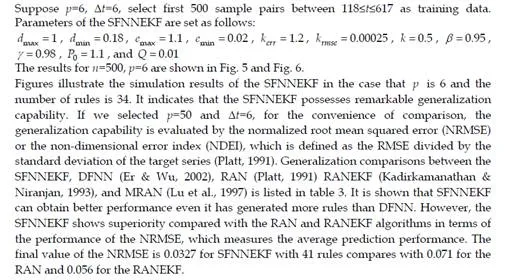
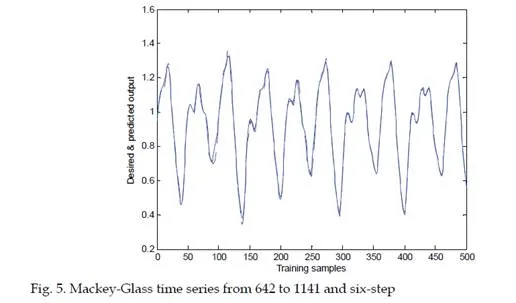


Conclusions
A new self-constructing fuzzy neural network has been proposed in this part. The basic idea of the proposed approach is to construct a self-constructing fuzzy neural network based on criteria of generating and pruning neurons. The EKF algorithm has been used to adapt the consequent parameters when a hidden unit is not added. The superior performance of the SFNNEKF over some other learning algorithms has been demonstrated in three examples in this part. Simulation results show that a more effective fuzzy neural network with high accuracy and compact structure can be self-constructed by the proposed SFNNEKF algorithm.
An euronpruning algorithm based on optimal brain surgeon for self-organizing fuzzy neural networks with parsimonious structure
In this section, a novel learning algorithm for creating a self-organizing FNN to implement TSK type fuzzy models is proposed. The optimal brain surgeon (OBS) (Hassibi & Stork, 1993) is employed as a neuron pruning mechanism to remove unimportant neurons directly during the training procedure. Distinguished from other pruning strategies based on the OBS, there is no need to calculate the inverse matrix of Hessian, we simplify the calculation by using LLS method to obtain the Hessian matrix. To acquire precision model, the LLS method is performed to obtain the consequent parameters of the network. The proposed algorithm has a parsimonious structure and is generated with high accuracy. The effectiveness of the proposed algorithm is demonstrated in several well-known benchmark problems such as static function approximation, two-input nonlinear function approximation and real-world non-uniform benchmark regression problems. Simulation studies are compared with other existing published algorithms. The results indicate that the proposed algorithm can provide comparable approximation and generalization performance with a more compact structure and higher accuracy.
Learning algorithm of the FNN
The learning procedure of the proposed self-organizing FNN comprises two stages. In the first stage, the structure of the FNN is generated based on the growth criteria and the proposed OBS-based pruning method. In the second stage, parameters of newly created neurons are assigned and consequent parameters of all existing neurons will be updated by the LLS method.
StructuredesignoftheFNN
To determine the proper number of neurons or fuzzy rules of FNNs, we adopt two growth criteria to generate neurons. In order to obtain a compact structure, the OBS algorithm (Hassibi& Stork, 1993) is employed as a pruning criterion. An initial structure of the FNN is first constructed and the importance of each hidden neuron or fuzzy rule is evaluated by the OBS algorithm, the least important neuron will be deleted if the performance of the entire network is accepted after deleting this unimportant neuron. This procedure will repeat until the desired accuracy can be satisfied. We will describe the learning algorithm in detail in the sequel.The learning stage is based on a data set composed by n input-output pairs:



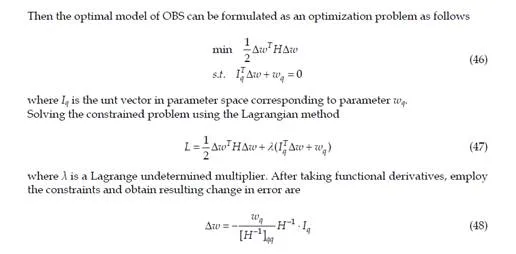
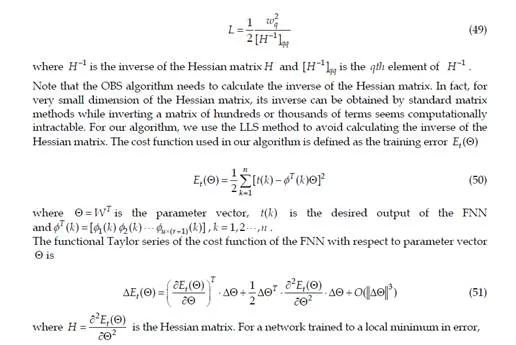
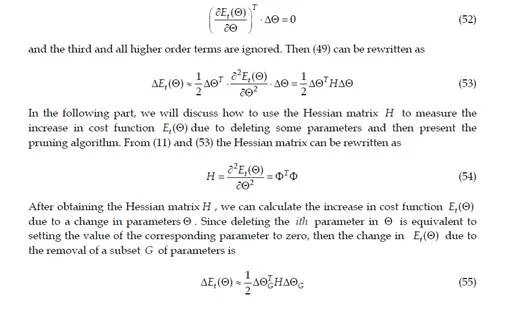
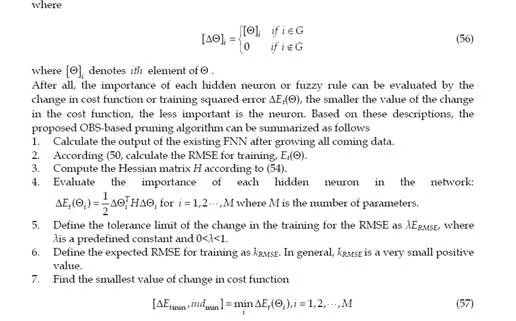
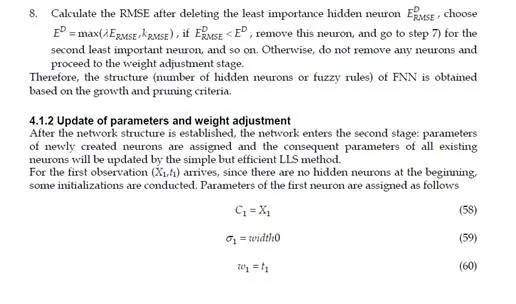
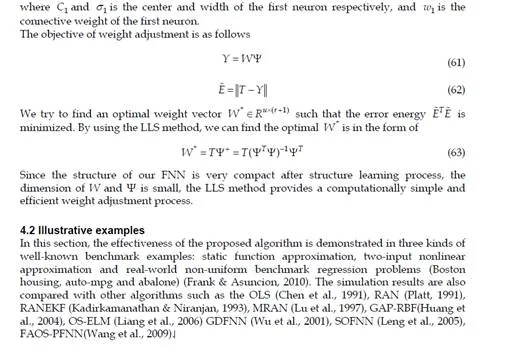
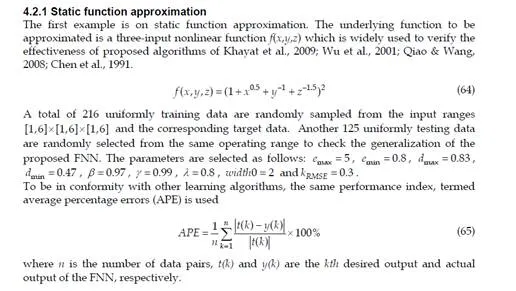
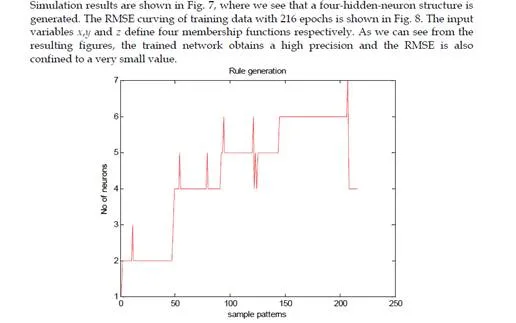
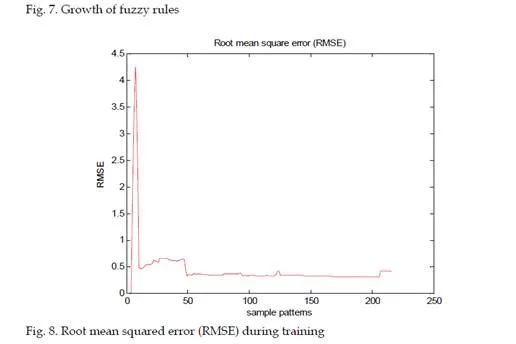


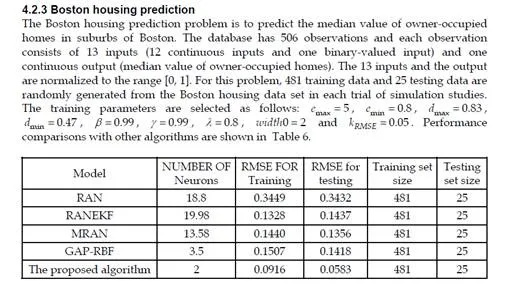
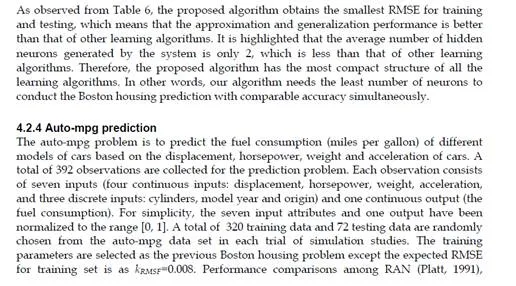
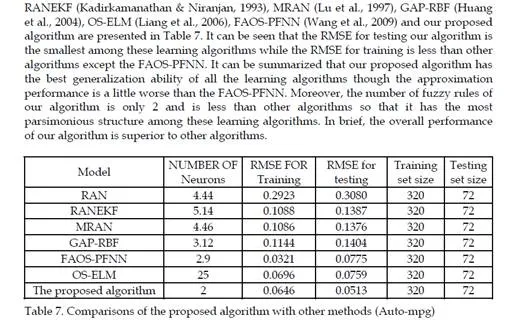

Discussions
In this part a novel learning algorithm for creating a self-organizing fuzzy neural network (FNN) to implement the TSK type fuzzy model with a parsimonious structure was proposed. The OBS is employed as a pruning algorithm to remove unimportant neurons directly during the training process. Apart from other pruning strategies based on the OBS, there is no need to calculate the inverse matrix of Hessian; we simplify the calculation by using the LLS method to obtain the Hessian matrix.The effectiveness of the proposed algorithm has been demonstrated in four well-known benchmark problems: namely static function approximation, nonlinear dynamic system identification, two-input nonlinear function and real-world non-uniform benchmark problems. Moreover, performance comparisons with other learning algorithms have also been presented in this part. The results indicate that the proposed algorithm can provide comparable approximation and generalization performance with a more compact parsimonious structure and higher accuracy.
Conclusions and future work
In this chapter, the development of fuzzy neural networks has been reviewed and the main issues for designing fuzzy neural networks including growing and pruning criteria and different adjustment methods of consequent parameters have been discussed. The general frame of fuzzy neural networks based on radial basis function neural networks has been described in Section 2. Two self-organization FNNs have been developed. For the first FNN, the SFNNEKF algorithm employs ERR as a generation condition in constructing the network which makes the growth of neurons smooth and fast. The EKF algorithm has been used to adjust free parameters of the FNN to achieve an optimal solution. Simulation results show that a more effective fuzzy neural network with high accuracy and compact structure can be self-constructed by the proposed SFNNEKF algorithm. For the second FNN, it is composed of two stages: the structure identification stage and the parameter adjustment stage. The structure identification consists of constructive and pruning procedures. An initial structure starts with no hidden neurons or fuzzy rule sets and grows neurons based on the criteria of neuron generation. Then the OBS is employed as a pruning strategy to further optimal the obtained initial structure. At last, the well-known LLS method is adopted to tune the free parameters in the parameter adjustment stage for sequentially arriving training data pairs. Simulation studies are compared with other algorithms. The simulation results indicate that the proposed algorithm can provide comparable approximation and generalization performance with a more compact structure and higher accuracy.
In a word, fuzzy neural networks are hybrid systems that combine the advantages of fuzzy logic and neural networks, there existed many kinds of FNN developed by researchers. Recently, the idea of self-organizing has been introduced in FNN. The purpose is to develop self-organizing fuzzy neural network systems to approximate fuzzy inference through the structure of neural networks to create adaptive models, mainly for approximate linear and nonlinear and time-varying systems. FNNs have been widely used in many fields. For our future work, studies will focus on the structure learning since appropriate number of fuzzy rules or find proper network architecture and developing optimal parameter adjustment methods.


